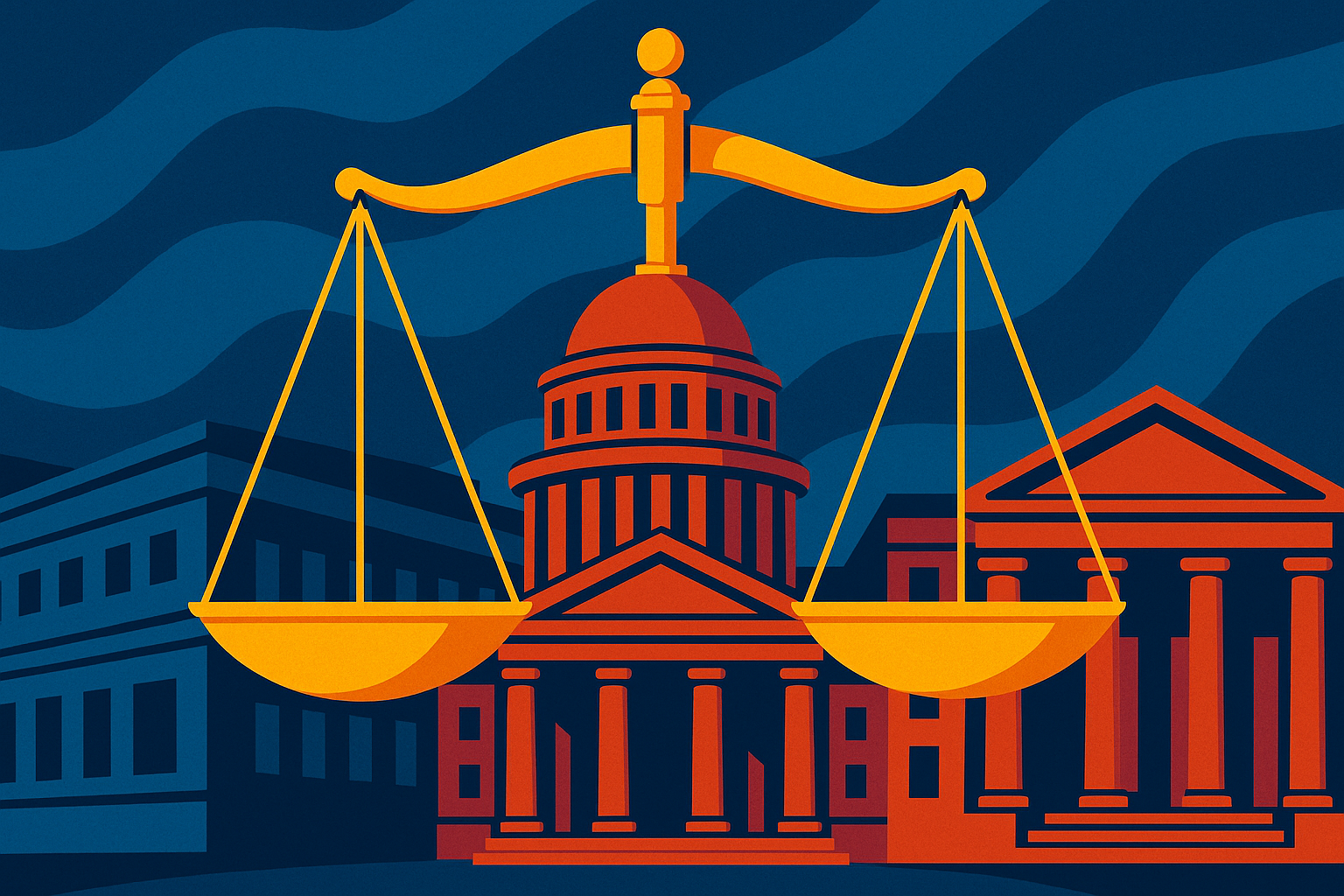Office of the Principal Legal Advisor:
Immigration Prosecutors & More
Date of Information: 08/24/2025
Check back soon; we update these materials frequently

1. Overview
The Office of the Principal Legal Advisor (OPLA) is the largest legal program within the Department of Homeland Security (DHS), employing over 1,100 attorneys and hundreds of support staff across more than 60 locations nationwide. It serves as DHS’s exclusive representative in immigration removal proceedings before the Executive Office for Immigration Review (EOIR), handling cases involving criminal noncitizens, terrorists, and human rights abusers, among others (ice.gov).
2. Legal Authority & Foundations
Statutory & Regulatory Authority
6 U.S.C. § 252(c) establishes OPLA’s statutory authority as DHS’s exclusive representative in EOIR proceedings.
Congress explicitly chartered OPLA to represent ICE in administrative immigration litigation and to provide specialized legal advice to ICE officers, agents, and other personnel (ice.gov).
Prosecutorial Discretion Authority
Historically, OPLA attorneys followed centralized guidance, including the Mayorkas Memo (Sept 30, 2021) and the Doyle Memo (Apr 3, 2022), which set priorities for exercising prosecutorial discretion in removal cases.
In June 2022, a federal court in Texas vacated the Mayorkas Memo, and because the Doyle Memo was built on that framework, neither memo is currently in effect (grassley.senate.gov, ilrc.org).
Nevertheless, OPLA attorneys retain their inherent prosecutorial discretion, exercised on a case-by-case basis as part of their long-standing authority.
In September 2023, DHS issued Director’s Memorandum 23-04, providing updated guidance to immigration judges under 8 C.F.R. § 1003.0(b). This memo guides EOIR proceedings broadly but does not replace OPLA’s own discretion policies (justice.gov).
Mission & Professional Standards
OPLA’s mission includes protecting the homeland through diligent litigation, timely legal advice, and adherence to high professional conduct standards (aila.org).
3. History & Context: How OPLA Came to Be
Before 2003: The Role of INS
Prior to the Homeland Security Act, the Immigration and Naturalization Service (INS)—housed within the Department of Justice—was responsible for both the enforcement and service functions of immigration law.
Within INS, the General Counsel’s Office performed the prosecutorial role in immigration court, representing the government in removal proceedings before the Executive Office for Immigration Review (EOIR).
This dual structure (INS as both the enforcement agency and the service provider) was widely criticized for conflicts of interest, since the same agency processed immigration benefits (like naturalization) while also pursuing deportations.
2001: The September 11 Terrorist Attacks
The terrorist attacks of September 11, 2001, exposed serious deficiencies in the U.S. government’s ability to coordinate domestic security, intelligence, and immigration enforcement.
In the aftermath, there was an intense period of congressional inquiry, internal executive branch review, and public debate about how best to prevent future attacks. The 9/11 Commission Report later documented many of these failures, particularly the lack of coordination across federal agencies.
This process of self-examination and reform made clear that the nation needed a unified structure to oversee border security, immigration enforcement, and domestic counterterrorism functions.
2002: Creation of the Department of Homeland Security
In response, Congress passed the Homeland Security Act of 2002, signed into law on November 25, 2002. This represented one of the largest federal reorganizations in U.S. history, consolidating 22 different agencies under the new Department of Homeland Security (DHS) (aila.org).
2003: Restructuring of Immigration Functions
When DHS began operations in March 2003, it dismantled the INS and redistributed its functions into three new agencies:
U.S. Citizenship and Immigration Services (USCIS) – handling immigration benefits.
U.S. Customs and Border Protection (CBP) – managing ports of entry and border enforcement.
U.S. Immigration and Customs Enforcement (ICE) – handling interior enforcement, including removal proceedings.
2003 Onward: The Emergence of OPLA
Within ICE, OPLA was created (by congressional charter) to centralize the government’s legal function—providing litigation in removal proceedings and legal advice to ICE enforcement personnel.
From its inception, OPLA was designed as a national legal presence, with headquarters in Washington, D.C., and Chief Counsel offices across the U.S. (ice.gov, aila.org, pressreleasepoint.com).
4. Practical Tips & Understanding
For immigrants and advocates, it’s important to know:
OPLA represents the U.S. government—not the individual.
Prosecutorial discretion is still available but is exercised case by case, without the centralized frameworks of the vacated Mayorkas or Doyle memos.
OPLA attorneys are centrally organized to ensure consistent representation across all immigration courts.
5. Frequently Asked Questions About OPLA (ICE Immigration Prosecutors)
1) What is OPLA?
The Office of the Principal Legal Advisor (OPLA) is the legal office of ICE. OPLA attorneys (immigration prosecutors) represent the Department of Homeland Security (DHS) in Immigration Court removal cases.
2) How is OPLA different from EOIR, USCIS, CBP, and ICE-ERO/HSI?
EOIR (DOJ) runs Immigration Courts and the BIA; judges work for DOJ, not DHS.
USCIS (DHS) adjudicates immigration benefits (affirmative asylum, green cards, naturalization).
CBP handles ports of entry/border.
ICE-ERO detains and removes people; HSI investigates crimes.
OPLA provides the lawyers who prosecute removal cases for DHS in Immigration Court.
3) What do OPLA attorneys do in court?
They file and litigate Notices to Appear (NTAs), oppose or agree to bond positions, present evidence (such as Form I-213), examine witnesses, file motions (to continue, pretermit, reopen, reconsider), and appeal to the BIA.
4) What is “prosecutorial discretion” (PD) and can OPLA exercise it?
Yes. PD is the government’s choice to prioritize or resolve a case (e.g., dismissal, administrative closure where available, stipulations, or narrowing issues). PD criteria evolve; strong equities (family ties, medical issues, victims/witnesses, military service, humanitarian factors) often matter.
5) Can OPLA agree to terminate or dismiss a case?
In some situations, yes—particularly when the NTA is defective, the respondent has clear relief elsewhere (e.g., USCIS), or the equities and enforcement priorities support dismissal. It is case-specific.
6) Will OPLA stipulate to eligibility or facts?
Sometimes. OPLA can stipulate to certain facts (identity, entry date, removability) or to elements of relief (e.g., good-faith marriage evidence) to narrow the trial. Stipulations should be written and filed with the court.
7) What’s Form I-213 and why is it important?
Form I-213 (Record of Deportable/Inadmissible Alien) is a common DHS evidence form documenting how DHS learned about the respondent and key facts. It’s presumptively reliable but can be challenged for inaccuracy, coercion, or contradictions with the record.
8) How do I request evidence from OPLA?
There is no broad civil “discovery” rule in Immigration Court. Practitioners use targeted requests to OPLA, FOIA to DHS components (ICE, CBP, USCIS), and, in rare cases, subpoena requests through the IJ. Keep requests narrow and relevant.
9) Does OPLA have disclosure/ethics obligations like Brady?
Immigration proceedings are civil, not criminal, but OPLA attorneys are still officers of the court and must follow professional-responsibility rules; they should not present false or misleading evidence and should correct material errors known to them.
10) Can OPLA agree to bond or parole for detained clients?
OPLA can take a position on bond (oppose, not oppose, or agree to a set amount) in custody hearings. Parole decisions are typically by ICE-ERO, not OPLA, though OPLA may provide input.
11) How does OPLA interact with an asylum or other relief application?
OPLA may oppose or not oppose relief; it can cross-examine, challenge credibility, or stipulate to elements to streamline issues. For strong cases, OPLA may consider PD to dismiss so the respondent can pursue relief directly with USCIS.
12) Can OPLA appeal if the judge grants relief?
Yes. OPLA can appeal to the BIA. Likewise, if the IJ denies relief, OPLA will defend that decision on appeal.
13) How do I ask OPLA for PD?
Send a PD request packet to the local OPLA office or designated email per local practice. Include a concise cover letter, evidence of equities (family, work, medical, community ties), criminal records (if any), and a proposed resolution (dismissal, stipulation, termination, or scheduling relief with USCIS).
14) What if my client has a strong USCIS case—will OPLA dismiss?
Often the most persuasive PD requests show clear USCIS eligibility (e.g., approved I-130, prima facie VAWA, SIJS findings, approved I-140 with adjustment eligibility). OPLA may dismiss so the client can pursue benefits at USCIS, but it is not guaranteed.
15) Does OPLA ever join motions to reopen or reconsider after a final order?
Yes—OPLA can join a motion in limited circumstances (e.g., to allow USCIS relief, to correct legal error, or in humanitarian situations). A joint motion is usually stronger than a unilateral filing.
16) What is ECAS and how do I serve OPLA?
ECAS is EOIR’s e-filing system. Most filings are served on OPLA by electronic service through ECAS or by email/other method if required locally. Check the local OPLA standing order/website for addresses and service rules.
17) How do PD and “administrative closure” work today?
Administrative closure availability depends on circuit law and current policy. Where permitted, OPLA may agree to close a case; elsewhere, PD might mean dismissal or continuance instead. Ask about your jurisdiction’s practice.
18) What happens if OPLA believes the NTA or removability is defective?
OPLA can amend or supersede the NTA, move to continue, or, in some cases, dismiss. Defense counsel can challenge jurisdictional or pleading defects; OPLA’s response will depend on the facts and controlling law.
19) Can OPLA issue subpoenas or compel witnesses?
Subpoenas are issued by the Immigration Judge upon a party’s request. OPLA can request subpoenas; respondents can too, but the IJ decides.
20) If I win relief, does OPLA handle post-grant steps?
Post-grant processing (e.g., card production) is typically with USCIS. OPLA’s role usually ends with the court order (unless there’s an appeal).
21) Do I need a lawyer to deal with OPLA?
You’re not required to have one, but OPLA litigates removal cases daily. An experienced immigration attorney can negotiate PD, challenge evidence, and preserve issues for appeal.
6. Conclusion
The Office of the Principal Legal Advisor (OPLA) plays a decisive role in U.S. immigration enforcement. Its attorneys act as the government’s prosecutors in removal proceedings, guiding the way DHS enforces immigration law in the courtroom. While OPLA does not represent immigrants, understanding its mission, history, and authority helps you better navigate the complex world of immigration court.
Whether you are facing removal, seeking relief, or simply trying to understand the process, knowing how OPLA operates is critical to protecting your rights and preparing an effective defense.
Need Help with OPLA?
If you are in removal proceedings or expect to interact with OPLA attorneys, it’s important to have skilled legal representation on your side. Our firm provides strategic, experienced advocacy to help you navigate immigration court and defend your future.
Other Helpful Resources:
See Also:
CIL Guide to the Circumvention of Lawful Pathways Rule
